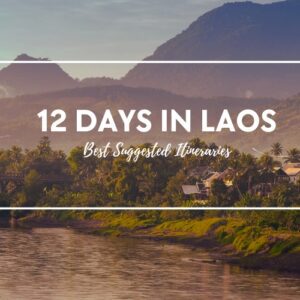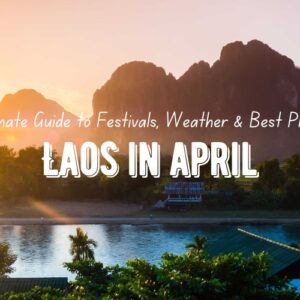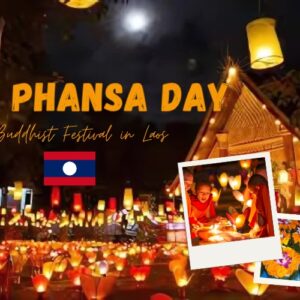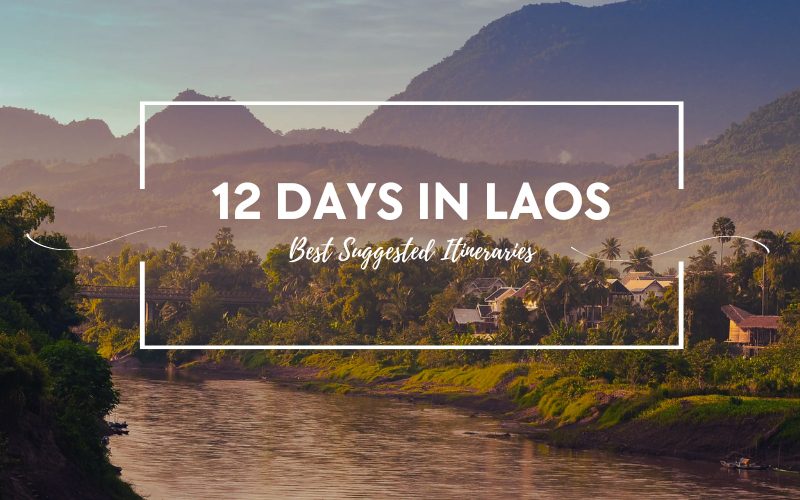
Planning an unforgettable journey through Southeast Asia? Look no further than Laos. This captivating country, with its rich cultural heritage and stunning landscapes, offers a perfect blend of adventure, relaxation, and discovery. In this article, we’ll take you through the best things to do in 12 days in Laos with experience of top attractions and thrilling activities. At the end of the article, we will also suggest some comprehensive itineraries so that you can make the most out of your time in Laos.
Best Things to Do in 12 Days in Laos
Admire Ancient Temples
Laos, like many other Asian countries, is rich in stunning temples waiting to be explored. Wandering through the serene grounds of golden monasteries is truly soothing for the soul.
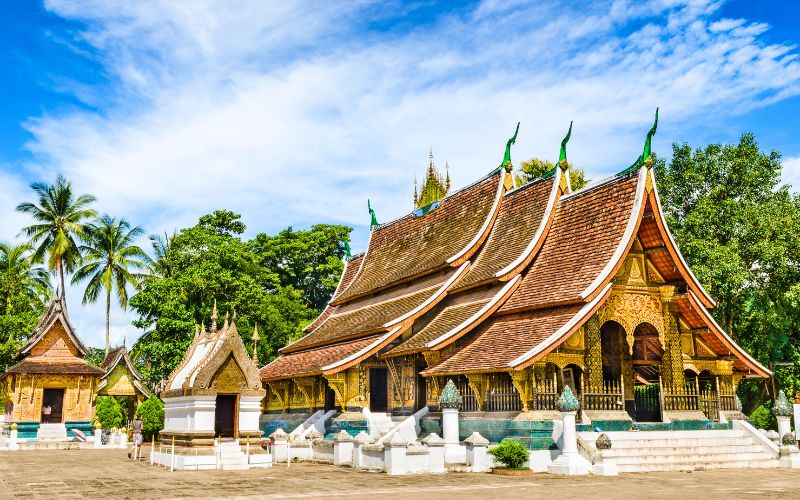
Wat Xieng Thong in Luang Prabang
In the ancient town of Luang Prabang, there are 33 temples adorned in gold. You can easily spend an entire day just exploring these sacred sites. A climb up Mount Phu Si, for example, offers breathtaking 360-degree views of Luang Prabang, along with the chance to see giant Buddhas carved into the cliffs. Make sure to visit Wat Mai Suwannaphumaham before strolling down Sakkarin Road, where temples line the street every 100 meters. At the confluence of the Mekong and Nam Khan rivers, you’ll find Wat Xieng Thong, the city’s most impressive temple.
Vientiane, the capital of Laos, is also home to numerous beautiful temples, with Pha That Luang being the most remarkable. This striking gold-covered stupa dominates the city skyline and is especially breathtaking when illuminated at night.
Traveling further south, Wat Phou is a must-see. Located at the base of the lush Phou Khao mountains in Champasak province, Wat Phou is one of Laos’ most famous temple complexes and a UNESCO World Heritage site. While some ruins date back over 1,000 years, most structures are from the 11th to 13th centuries. Often compared to Cambodia’s magnificent Khmer temples, Wat Phou is now a Theravada Buddhist site and a popular tourist attraction in Southern Laos.
>>> You may also like the Top 11 Most Famous Buddhist Temples in Laos.
Join an Alms-giving Ceremony
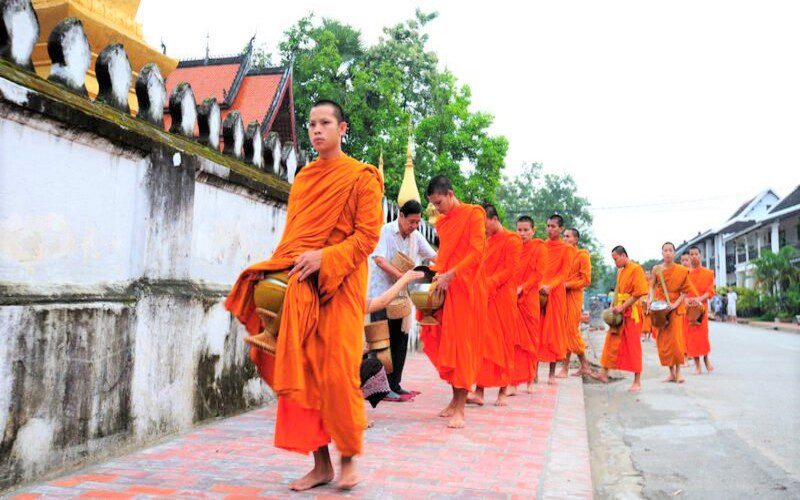
Alms-giving ceremony in Luang Prabang
The alms-giving ceremony in Luang Prabang is a deeply rooted tradition in Laos’ Buddhist culture, dating back to the 14th century. Every morning at sunrise, hundreds of saffron-robed monks silently walk through the town’s streets to collect their daily meal. These monks and novices come from various temples across Luang Prabang.
Local residents rise early to prepare food for the monks, waiting quietly by the roadside to offer their gifts. Some children also participate, kneeling with baskets, and the monks often share some of their alms with them.
Wake up early and join the locals in this beautiful, age-old practice.
Take a Boat Trip along the Mekong or Nam Ou Rivers
Laos also offers an impressive array of water-based adventures, for example, the river cruise.
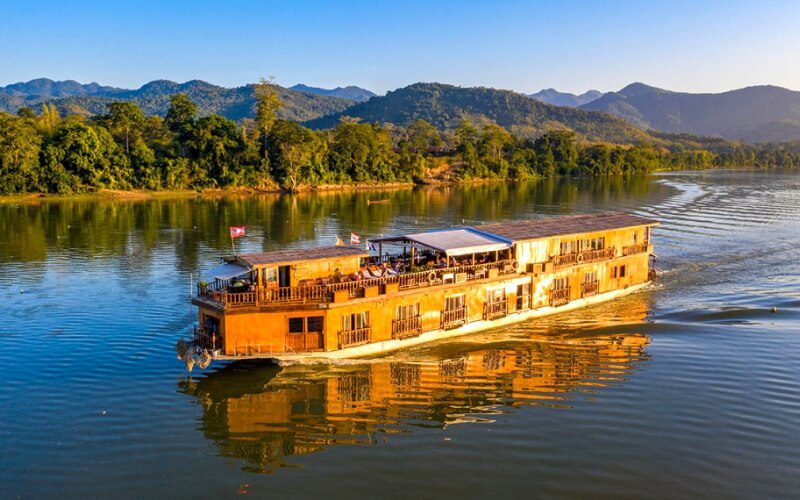
Mekong River Cruise
The Mekong and Nam Ou Rivers in this country form the backbone of a thriving river cruise network, stretching from Luang Prabang in the north to Pakse in the south. Along these routes, travelers can experience some of Laos’ top cultural sites while gliding past breathtaking mountains and picturesque villages.
Starting in Luang Prabang, you can cruise up to the Pak Ou Caves, which are filled with countless Buddha statues placed by devotees. Continuing further, the cruise takes you to Huay Xai, with an overnight stop at Pakbeng. Huay Xai is a border town near key attractions in Northern Thailand, such as Chiang Rai and Chiang Mai, making this route popular among travelers moving between the two countries.
From Pakse, cruises along the Mekong River will bring you to visit famous tourist destinations of southern Laos, such as Wat Phou and Si Phan Don.
Go Trekking in Laos
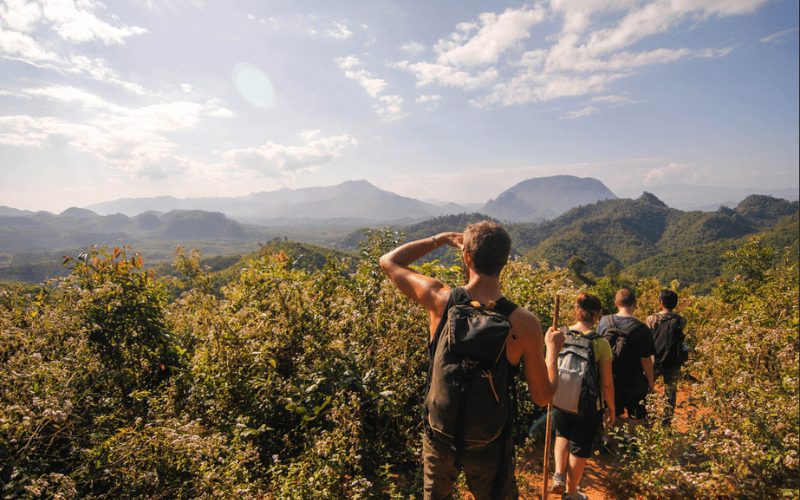
Trekking in Laos
Surrounded by mountains and jungles, Laos is a paradise for trekking enthusiasts. Trails range from easy strolls on marked pathways to challenging routes deep into the wilderness.
Trekking in Laos allows you to immerse yourself in unspoiled nature and discover hidden places far from the usual tourist spots. Many treks lead to remote ethnic villages where traditional ways of life have remained unchanged for centuries. Along the way, you’ll encounter diverse wildlife, breathtaking waterfalls, stunning cave systems, majestic mountain scenery, dense forests, scenic river journeys, and ancient ruins.
One popular starting point for trekkers is the charming riverside town of Nong Khai, which has become a hub for trekking tour operators. Another excellent spot is the northern town of Luang Namtha, near the Chinese border. Here, you can hike through pristine rainforests and visit hill tribe communities in the protected Nam Ha Reserve.
In Northeast Laos, the remote province of Phongsaly, on the border with China, offers some of the country’s most pristine mountains and adventurous trails. This less-traveled corner of Laos is perfect for those seeking to venture off the beaten path.
Discover Beautiful Waterfalls
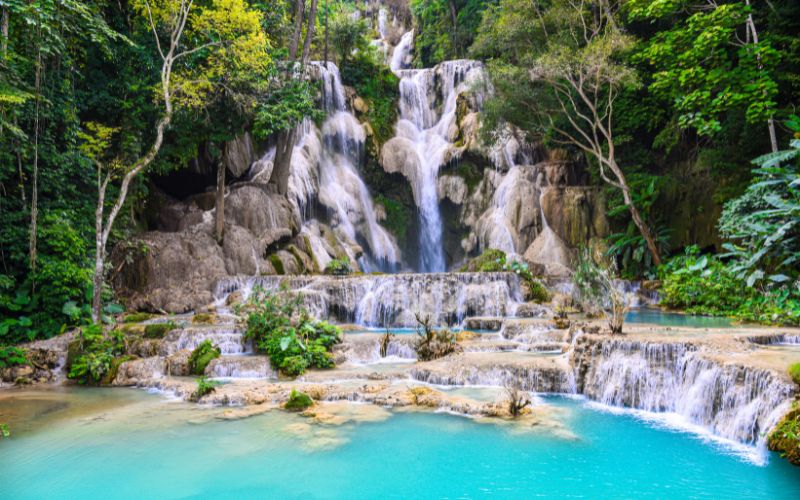
Kuang Si waterfalls
With 12 days in Laos, don’t miss out on the chance to explore its thrilling waterfalls. The first is Kuang Si Falls near Luang Prabang. This waterfall features three tiers leading to a 50-meter drop into shallow pools before flowing downstream. These pools are perfect for swimming, and you can change into your swimwear at wooden huts near the entrance. Surrounded by lush tropical jungle, the turquoise pools have cascades up to 5 meters high.
For an added thrill, you can climb to the top and jump into the water. Another picturesque spot for swimming near Luang Prabang is Tad Sae Waterfall, where you can relax on the rocks or take a dip in one of the turquoise pools.
In southern Laos, the Bolaven Plateau is a great place to visit some of the country’s most impressive waterfalls. Tad Fane is the most famous, featuring twin falls that cascade from a forest-covered rock face through majestic jungle foliage. Further north in Salavan province is Tad Lo village, which has three waterfalls within hiking distance: Tad Suong, Tad Lo, and Tad Hang.
In the south, Si Phan Don is home to the magnificent Khone Phapheng Falls, the largest waterfall in Southeast Asia. Known as the “Niagara of Asia,” its cascading waters crash and froth over the rocks.
For a more affordable and quieter experience, head to Don Khon to find the fast-flowing rapids of Tat Somphamit, also known as Khon Pa Soi Falls.
Sample Delicious Laos Cuisine

Laap – A must-try Laos dish
Exploring a new destination through its cuisine is an authentic way to discover the local culture. Lao cuisine is known for its intense spiciness, often featuring a subtle bitterness rather than sweetness. The locals use an abundance of fresh herbs and raw vegetables. The staple food is sticky rice (khao niaow), eaten by hand from small baskets called tip khao. To eat, pinch off a bit of rice, roll it into a ball, and dip it into various dishes.
The national dish of Laos is laap, a “salad” of minced meat mixed with herbs, spices, lemon juice, and chili. Sometimes, the meat is served raw instead of cooked. Another staple is tam maak hung, a spicy green papaya salad. Other popular dishes include ping kai (spicy grilled chicken) and mok pa (fish steamed in a banana leaf).
In addition to food, you should try Beer Lao, a source of national pride. Made from Laotian jasmine rice, one of the few exports from Laos, this beer is as ubiquitous as water. You can find it everywhere, from remote street stalls to bustling tourist bars in Vang Vieng and Luang Prabang. Beer Lao is a smooth, savory, and light brew that pairs well with any meal.
Suggested Itineraries for 12 Days in Laos
Itinerary 1: Laos Classic Tour 12 Days
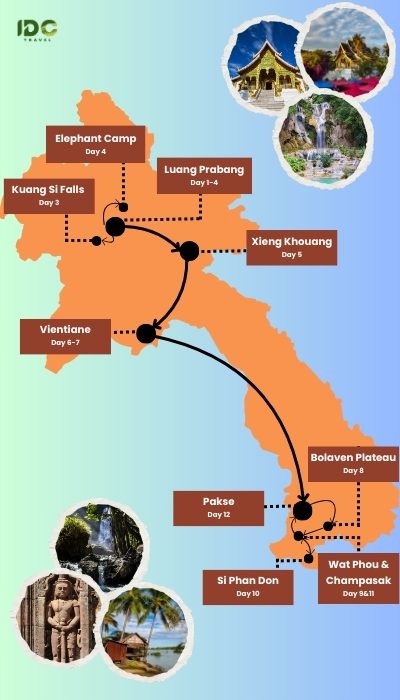
Day 1 – Arrive in Luang Prabang.
Day 2 – Luang Prabang city tour: Visit the morning market, then head to Wat Mai, Wat Xieng Thong, UXO Visitor’s Center, and Wat Visoun. End your day with a climb to the top of Mount Phousi.
Day 3 – Explore Pak Ou Caves & Kuang Si Falls.
Day 4 – Visit an Elephant Park: Meet with this giant animal and ride around the park to enjoy the natural scenery.
Day 5 – Fly to Xieng Khouang & Visit the Plain of Jars.
Day 6 – Fly to Vientiane: Visit the Patuxai Monuments and COPE Visitor Center.
Day 7 – Vientiane city tour: Check out famous temples in Vientiane, such as Wat Sisaket, at Prakeo, Pha That Luang, Wat Ong Tue, and Wat Haysoke. Also, visit the Laos National Museum and Vientiane Central Market.
Day 8 – Fly to Pakse & Transfer to Champasak: Time to explore the Bolaven Plateau.
Day 9 – Visit the ruins of Wat Phou.
Day 10 – Day tour to Si Phan Don (4000 Island): Hop on a boat to discover Don Khone Island, check out the majestic Lippi Waterfall, and witness the famous Irrawaddy dolphins.
Day 11 – Free day in Champasak.
Day 12: Transfer to Pakse & Depart. End of 12 days in Laos.
>>> Detailed itinerary: Laos 12 Days Classic Tour.
Itinerary 2: Adventure Tour in Laos 12 Days
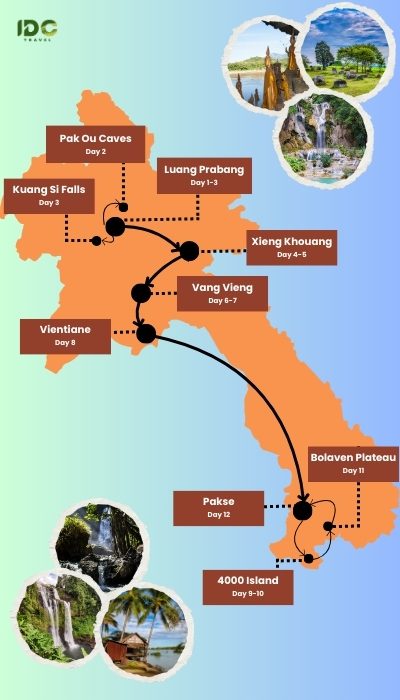
Day 1 – Arrive in Luang Prabang: Join a half-day city tour if time permits.
Day 2 – Visit Pak Ou Caves: Before that, you will visit a small school in Ban Khia Luang to meet and play with the local kids.
Day 3 – Discover Kuang Si Waterfalls: En route, visit the morning Phousi Market. Today, it is your chance to swim in the topaz pools of the fall, visit a Bear Sanctuary, or walk along the forest trails.
Day 4 – Drive to Xieng Khouang.
Day 5 – Explore the Plain of Jars & Muang Khoun: Stop at Sites 1, 2, and 3 of this complex. After lunch, transfer to Muang Khoun to see a Hmong hill tribe village.
Day 6 – Transfer to Vang Vieng: En route stop at Phonsavan Central Market.
Day 7 – Half-day city tour & transfer to Vientiane: Discover the famous Tham Jang caves and Ban Huai Ngai village to meet and talk with the local people.
Day 8 – Half-day Vientiane city tour: Visit famous monuments like Wat Sisaket, Wat Prakeo, That Luang Stupa, etc.
Day 9 – Fly to Pakse & Onward travel to 4000 Islands.
Day 10 – Explore 4000 Islands: Start at Ban Khone to Liphi waterfall and stop at Ban Nakasang, where the Khone Phapeng waterfall is located.
Day 11 – Explore the Bolaven Plateau & Transfer to Pakse: Immerse in the cool atmosphere of this natural landscape and explore two famous waterfalls here, Tad Fan and Tad Ngeuan.
Day 12 – Depart Pakse.
>>> Click this link for the detailed itinerary of this tour. Or, refer to our Laos adventure tours for more adventurous activities in this country.
Itinerary 3: Explore Laos & Extend Your Trip to Vietnam
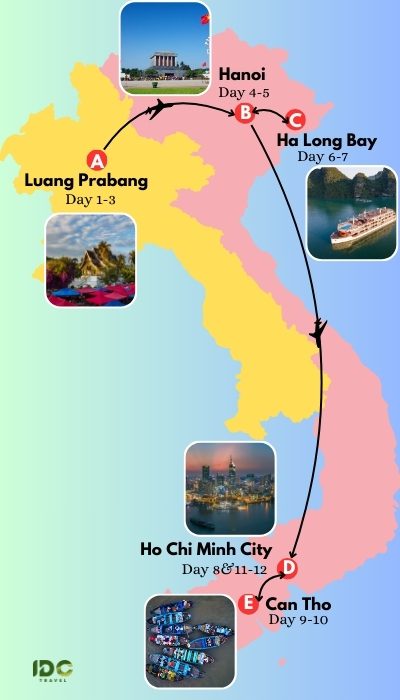
Day 1 – Arrive in Luang Prabang.
Day 2 – Luang Prabang half-day city tour & Explore Pak Ou Caves: Visit the magnificent temples of Wat Sene and Wat Xieng Thong before taking a cruise upstream to Pak Ou Caves. En route, stop to visit Ban Xanghai village.
Day 3 – Luang Prabang half-day city tour & Kuang Si Falls: Check out Wat Visoun, Wat Aham, and Wat Mai. Then, visit an ethnic village, Ban Ouray or Ban Ou. Finally, take the road to Kuang Si Falls to cool off in the pools or walk in the forest trails.
Day 4 – Fly to Hanoi.
Day 5 – Day tour to Ba Vi: Visit a tea hill in Ba Vi, where you can learn about manual tea production and join a cooking class with a local family. In the afternoon, join a riding experience through the beautiful rice paddies.
Day 6 – Transfer to Ha Long Bay & Embark on a cruise: Start your 2-day 1-night to discover this UNESCO World Heritage Site of Vietnam.
Day 7 – Ha Long Bay Discovery – Back to Hanoi: End of the cruise itinerary at around noon, disembark from the cruise and start your journey back to Hanoi.
Day 8 – Fly to Ho Chi Minh City.
Day 9 – Ho Chi Minh City – My Tho – Can Tho: Visit Vinh Trang Pagoda and the Unicorn Island in My Tho and Tan Thach village in Can Tho.
Day 10 – Visit the Cai Rang floating market & Return to Ho Chi Minh City.
Day 11 – Visit Cu Chi Tunnels: Learn about the history of the Vietnam War through an underground tunnel network,
Day 12 – Depart Ho Chi Minh City.
>>> Here is the detailed tour itinerary of this program. If it does not meet your expectations, please check out our full list of the best Vietnam – Laos tours for more options.
Mini Laos Travel Guide
Best Time to Visit Laos
The best time to visit Laos is during the cool, dry season from November to February. During these months, the weather is pleasantly mild, with temperatures ranging from 15°C to 30°C (59°F to 86°F). It is ideal for exploring the country’s rich cultural sites and natural beauty. The lower humidity and minimal rainfall also provide perfect conditions for trekking, river cruises, and sightseeing.
November is particularly special as it marks the end of the monsoon season, leaving the landscapes lush and vibrant. February is also a great time, as the tourist crowds start to thin out, offering a more peaceful experience. Additionally, several festivals of Laos, such as the That Luang Festival in Vientiane, occur during this period, providing a unique opportunity to immerse yourself in Lao culture and traditions.
>>> For more information on Laos weather, check out our article on When is the best time to visit Laos?
Transportation in Laos
It is easy to get around Laos thanks to a good mix of traditional and modern transportation. Buses are the most common form of long-distance travel, with both local and VIP buses available. VIP buses are more comfortable, often air-conditioned, and provide a smoother ride compared to local buses. For a more luxurious experience, consider hiring a private car with a driver.
For a quicker and more scenic journey, you can opt for riverboats along the Mekong and Nam Ou Rivers, which connect major destinations such as Luang Prabang, Vientiane, and Pakse.
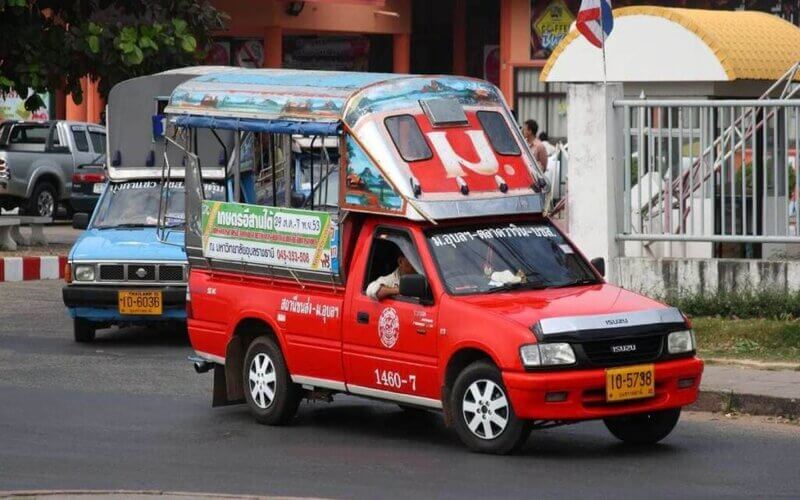
Songthaew in Laos
Tuk-tuks and songthaews (shared pickups) are popular for short distances within cities and towns, providing an affordable and authentic way to explore local areas. For more flexibility, renting a motorbike or bicycle is a great option, especially in smaller towns.
Domestic flights are also available between major cities, offering a faster alternative for longer journeys across the country.
Accommodation in Laos
Laos offers a wide range of accommodations, from budget-friendly guesthouses to luxurious hotels. In major cities like Vientiane and Luang Prabang, you’ll find a wide selection of hotels, boutique lodges, and international chains with modern amenities and high standards of comfort. Guesthouses and hostels are plentiful, they are affordable options for backpackers and budget travelers.
In rural areas and smaller towns, homestays are a popular choice for visitors to experience traditional Lao hospitality and gain insight into local life. Many of these accommodations offer basic facilities, but the warmth and friendliness of the hosts make up for the simplicity.
Eco-lodges and nature resorts are also gaining popularity, especially in regions like the Bolaven Plateau and Nam Ha National Park, where travelers can stay in environmentally sustainable settings to fully enjoy the natural beauty of Laos.
Dos and Don’ts in Laos
These are small things but very important for a perfect Laos trip:
- Always show respect for local customs and traditions. Remove your shoes before entering homes and temples, and dress modestly.
- Use the traditional Lao greeting, the “nop” (placing your palms together in a prayer-like gesture), especially when meeting elders or monks.
- When visiting religious sites, make sure your shoulders and knees are covered. Wearing long skirts or pants and shirts with sleeves is recommended.
- Respect monks, don’t touch them or their robes. Women should avoid direct contact and not sit next to them.
- When giving or receiving something, use both hands or your right hand supported by your left arm.
- Maintain a calm and polite demeanor. Losing your temper or showing frustration is considered disrespectful.
- Refrain from kissing or hugging in public. Such behavior is considered inappropriate.
- Avoid pointing at people or religious objects. Use your whole hand or chin to gesture instead.
- Avoid touching people’s heads, including children’s, as the head is considered sacred.
- Never step over food or other people’s belongings, as it’s seen as highly disrespectful.
- Always ask for permission before taking photos of people, especially monks and locals in traditional settings.
Above, we have suggested some itineraries for 12 days in Laos which cover all the best things to do in this country. Don’t hesitate to contact us if you need help planning your Laos trip. Thanks for your reading!
Read more:

